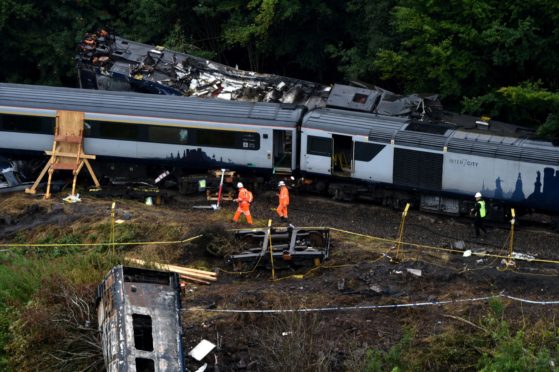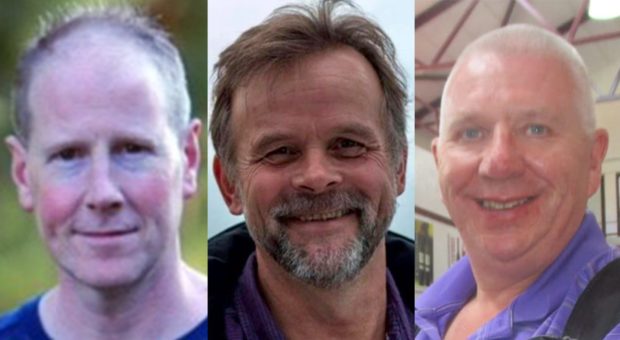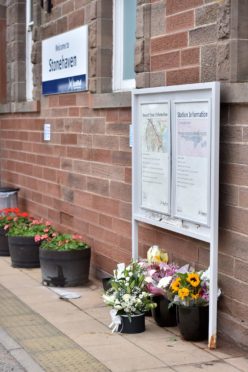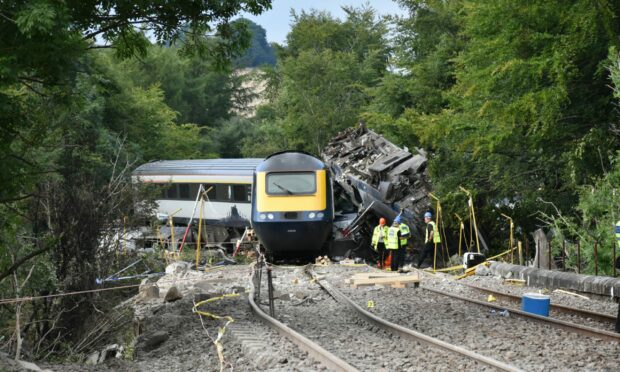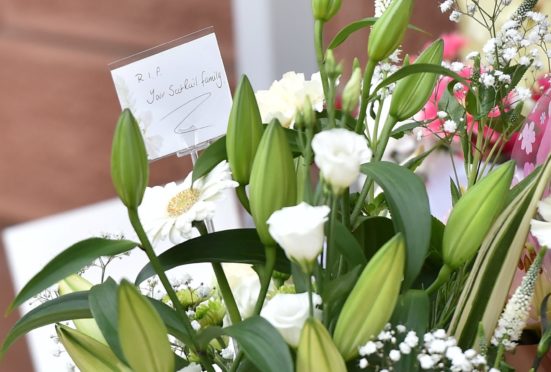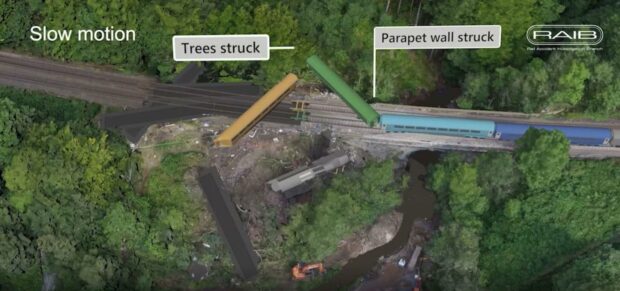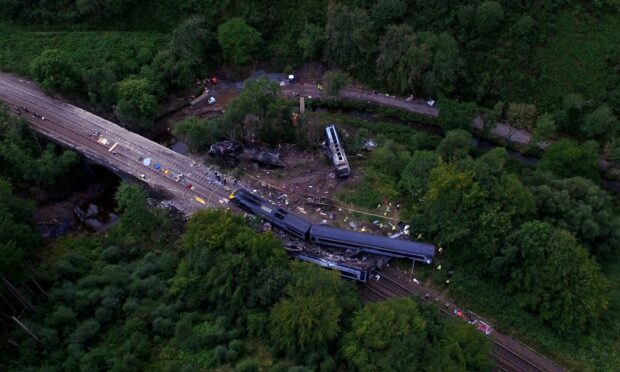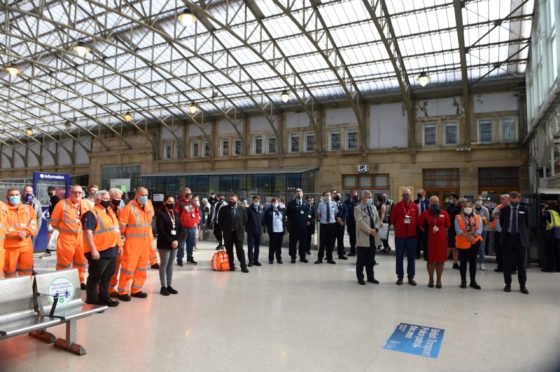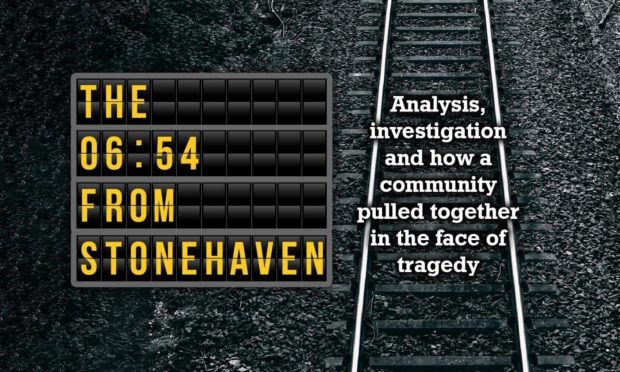Rail control room staff failed to limit the speed of a train that then crashed – despite knowing about hazards nearby, a new report has said.
Three people died when a train derailed near Stonehaven in August 2020 following a thunderstorm.
Safety officials spent 18 months investigating the derailment and have now published their findings.
They concluded there were multiple concerns, including a failure of Glasgow control room staff to impose a speed limit due to four obstacles within 11 miles of the crash scene.
Chilling final conversation
Chillingly, the report includes the final conversation of train driver Brett McCullough, who questioned whether a limit should be imposed given the heavy rain that day.
The report said that, during a conversation between Brett and the signaller, “the driver (Brett) queried whether there was any speed restriction to Stonehaven.
“The signaller replied that the line was fine between Carmont and Stonehaven, and the driver could proceed at normal speed.
“In response the driver said he would be in no rush to get there.”
Disbelief and anger
Crash survivors and loved ones of those who died have expressed their “disbelief and anger” at the findings, which have sparked 20 recommendations.
Now, victims’ representatives have urged Network Rail and six other organisations to implement all recommendations as soon as possible.
They have also started a legal fight for compensation.
The Rail Accident Investigation Branch (RAIB) published today’s report after speaking with dozens of individuals and organisations and studying thousands of documents.
On the morning of the crash, the ScotRail service left Aberdeen for Glasgow.
It passed Stonehaven and continued south – but then stopped at Carmont signal box as debris on the line was blocking its path.
Staff knew of four hazards
The train waited for two hours and staff decided it should return to Stonehaven.
By that point, control room staff knew of two landslips and two flooded parts of the track, the report said.
They also knew of multiple other flooding and debris incidents across Scotland.
But they did not notify the three staff at the scene of any need to limit speed on the train’s return to Aberdeen.
Rail rules meant those staff on the ground must follow those instructions as they come from people with a better overview of conditions.
Driver and signaller not responsible
So none of those three staff – the signalbox man, a Network Rail engineer sent to change the points so the train could go back to Aberdeen or the train’s driver Brett McCullough – were responsible for the crash in any way.
The RAIB report said: “Although aware of multiple safety-related events caused by heavy rain, route control staff were not required to, and did not, restrict the speed of the train.”
So the train set off and reached 73mph – close to the normal line speed for that section of track.
While travelling on a bend, the train struck debris washed out of a failed trackside drain.
The train struck a bridge parapet and several carriages fell on top of each other before a fire broke out.
Other failings in the report relate to Network Rail staff being under “severe workload pressure” and not being trained properly.
RAIB also commented that the train would have coped better after the crash if had the same safety standards of trains built after 1994.
It also said that post-crash movement of the train meant more damage and injury was caused than had measures been in place such as guardrails.
Guardrails have since been installed at the crash site.
Considering legal action
A spokesman for Digby Brown Solicitors, which represents many of the crash victims, said: “If just one of these failings were addressed, then then the accident may not have happened.”
The firm is one of three considering legal action against Network Rail.
A partner at Digby Brown, Neil Davidson, told us: “The overall reaction from our clients to this report was disbelief and anger.
“While they now know what happened, they are angry that numerous opportunities that presented themselves to those concerned weren’t acted upon.
“It was those inactions that led to the incident.”
Staff not properly trained
One failure relates to weather.
RAIB was so concerned there had been six landslips in eight months it ordered a probe.
Its 2014 report recommended Network Rail “implement a process for real-time collection of intelligence about very unusual rainfall or flooding conditions.”
Network Rail did introduce a weather service in 2015 but the latest RAIB report said: “Although the tool was accessible from the control room, this was not used by controllers as a source of information when managing the response to weather-related events.
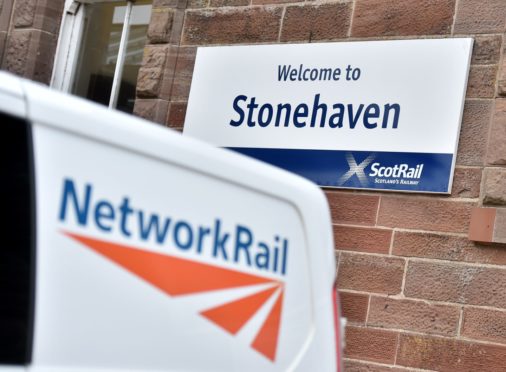
“This was because the NRWS had not been optimally configured for use in such circumstances and controllers had not been provided with the procedures or training needed to exploit its full capabilities.”
Drain was the wrong design
Four of the failings relate to the trackside drain that failed.
Now-defunct Carillion built the drain in 2012 – but it was the wrong design – so could not perform as intended during heavy rain.
But Network Rail never checked Carillion had done its job properly.
And when a neighbour complained about surface water there, neither Network Rail nor Carillion followed it up.
However, a Network Rail spokesman said there is no record of any complaint being received from the neighbour.
‘They failed to act’
Network Rail also did not put the drain’s existence into its database so it could not be maintained.
Mr Davidson added: “The RAIB investigation clearly shows rail management had prior knowledge of several known risks – they were told to improve, yet still failed to act.
“This is a damning report which highlights a catalogue of failures within Network Rail.”
We asked Network Rail’s manager Andrew Haines, who is paid £585,000 a year for an interview, but the organisation refused.
‘Not about blame’
In a statement, it said: “The report is not about apportioning blame, but about understanding what happened on August 12 and we will now carefully review the final report and the recommendations that RAIB makes.
“The report makes clear there are fundamental lessons to be learnt by Network Rail and the wider rail industry.
“Tragic accidents are thankfully incredibly rare and our railway is one of the safest in Europe.
“The whole rail industry has worked hard to identify where improvements can be made and we’ve invested heavily in learning lessons from previous events.
‘We are already doing more’
“There is clearly more to do and we can, and are, already doing more.
“It’s important the changes we make in light of this report sustain improvements in safety and are implemented in a timescale that makes changes stick.
“We need time to fully understand the just-published document and do not yet know the full extent of work required for responding to each recommendation.”
ScotRail chief operating officer Ian McConnell said: “This report is a terrible reminder of the awful events of August 12 2020.
‘A painful reminder of their loss’
“Nobody in ScotRail or the wider industry will ever forget what happened.
“Our thoughts and prayers remain with the families, friends, and colleagues of Brett, Donald, and Christopher.
“The publication of today’s report will be another painful reminder of their loss.
“While there is nothing we can ever say to ease that pain, we have been in contact with the families and continue to offer any support we can.
“This report makes for very sober reading.
“The RAIB is clear that the derailment was caused by debris washed out from a drain and onto the track, with failures in the specific drainage system installed by Network Rail in 2011/12 being a key factor.
“The majority of the RAIB recommendations relate to other parties but ScotRail will play its part fully in ensuring that safety lessons are learned.
“We are working closely with Network Rail and the wider industry to do everything possible to reduce the risk of something like this ever happening again.
“The way the industry responds to extreme weather incidents has already changed following the events of August 12 2020 and a number of the report’s recommendations have already been implemented.”
